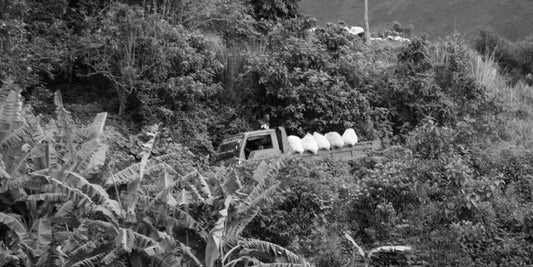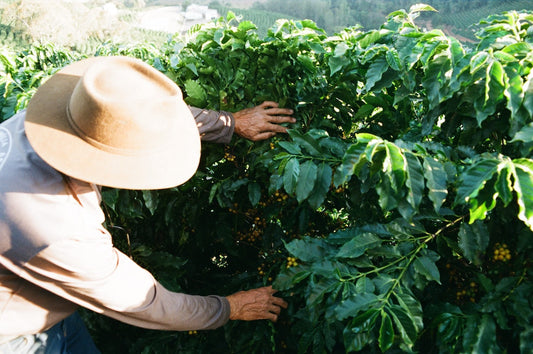
Whole beans vs ground coffee
Ok then *rubs hands together* it’s time to tackle this age-old question we hear ALL the time. “Yeah but, do you have to grind your own beans though? Isn’t that just, effort?” Well, sort of. But grinding your own beans ensures ultimate freshness and it’s the single most significant thing you can do to improve the quality of your coffee at home.
However, before we go completely writing off pre-ground coffee there are a few other things to consider. These are freshness, suitability and consistency of grind.

FRESHNESS
Staleness in coffee is the result of oxidation and both whole beans and pre-ground will eventually go stale. The main difference is once a whole bean is ground and broken into thousands of fragments its surface area exponentially increases. This means that oxidation will happen far quicker in ground coffee. However, it is feasible to get better results from a well-stored bag of pre-ground coffee than it is from a poorly stored bag of whole beans. Remember, oxygen is your enemy so always keep coffee stored as airtight as possible out of direct sunlight. No need to reach for the fridge or freezer, just a cool cupboard will do.
Most coffees are now sold in foil-lined bags with one-way valves, and while these may not be amazing for the environment, they are extremely effective at keeping the coffee inside fresh. How? Well, as soon as coffee is roasted or ground it gives off a large amount of CO2. If you pack coffee into a bag straight after roasting (as we do) the CO2 expressed out of the coffee replaces any residual oxygen inside the bag. It escapes out of the one-way valve and eventually, the vast majority of the gas inside the bag will be CO2, thus creating a kind of protective atmosphere for the coffee. So, on the freshness front, it’s Beans 1, Ground 0.
SUITABILITY OF GRIND
One of the major benefits of grinding your own beans is that you’ll be able to adjust your grind to suit your brew method. This is especially important if brewing espresso at home as the grind texture will determine the extraction speed. Too fine and you’ll over-extract the coffee, too coarse and the water will pass through too quickly and you’ll under-extract the coffee. Having a decent grinder at home will allow you to make small adjustments to optimise your extraction. Pre-ground coffee, on the other hand, has been ground to a certain texture at the roastery which is a bit of a “stab in the dark” approach. Not too much of a problem if you’re brewing a Cafetiere, but you’re unlikely to get the optimum extraction with espresso. Once again beans win this round, so now it’s Beans 2, Ground 0.
CONSISTENCY OF GRIND
Here’s an opportunity for pre-ground to claw back a point. Not all grinders were created equal. Home grinders can range from cheap and nasty electric blade grinders to something like the Niche which retails for a smidgen under £500. Hand grinders can vary enormously too. Just because most of them are burr grinders doesn’t mean they’re any good. Prices can vary enormously from £30 to well into the hundreds. On the other hand, for example, here at Roastworks we’ll grind your coffee on one of two, high precision industrial grinders. The first is called the Mahlkonig DK15, which is 150kg per hour bulk grinder costing over £6000 and the second is called a Ditting 1203 which costs £3000. For comparison, the coffee for our capsules is ground on a three-stage roller grinder that costs around a quarter of a million pounds! We don’t own that machine. That’s all done off-site. These machines do a wonderful job at grinding coffee, not just efficiently, but very consistently.
So, what do we mean by consistency? Coffee beans are quite brittle and when they’re ground they can shatter into numerous sized and shaped particles. Burr grinders are designed to move the coffee through the burr set to create a uniform size, but this is never 100% accurate. There will always be really fine bits, really big, coarse bits and everything in between. A good grinder will limit the amount of fine bits (we called these fines in the game) and coarse bits (we call these boulders), so that the vast majority of the grounds are more or less uniform. The more uniform the grind, the better your coffee will taste.

So, next time you’re whizzing your beans up on your rubbish electric blade grinder you bought from Amazon, just remember that you’d actually get far better results with pre-ground coffee. Don’t get me wrong, there are some very good domestic grinders out there (the Hario Mini Slim Pro, Porlex, Comandante, Wilfa Svart, Baratza Sette, Fellow Ode, Niche, to name a few), but you’ll have to spend a bit of money to get as consistent a grind as we can achieve on our commercial machines. I’d say pre-ground has won that one. It’s Beans 2, Ground 1.
So, that’s the final score pretty much. Beans have it. It’s definitely the way to go, especially if you want to really engage in the flavour of coffee. If you don’t have time, or you just can’t be bothered then pre-ground can work too, just know its limitations.




